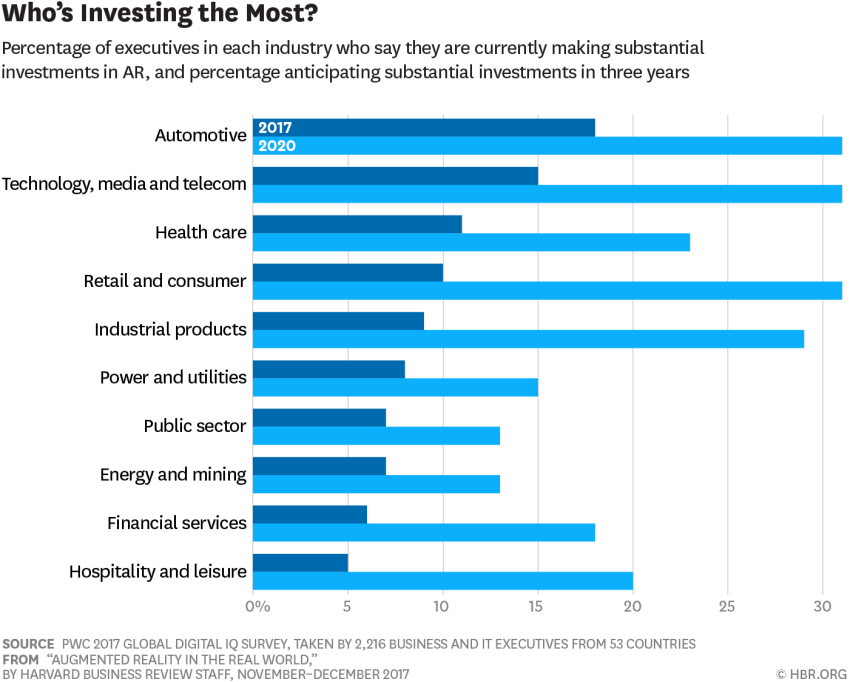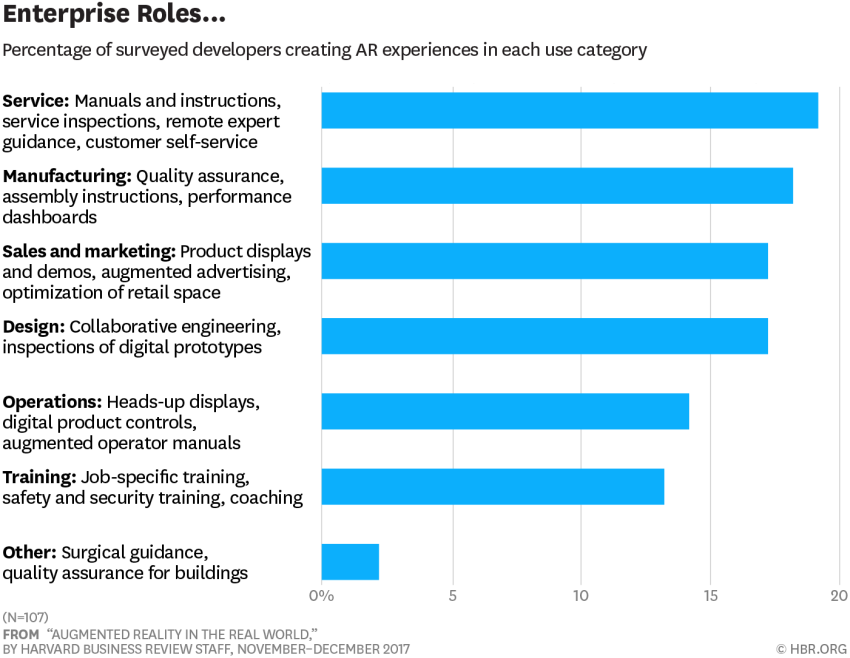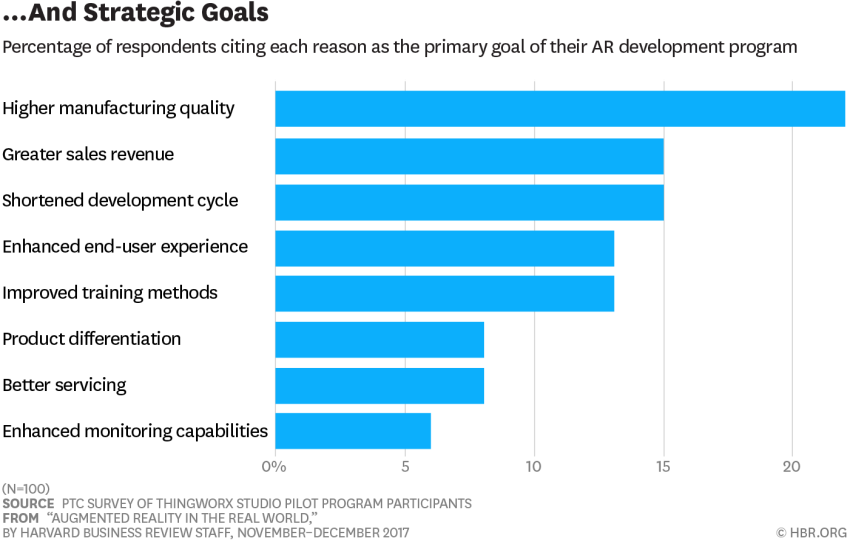From Boeing to DHL to Xerox, augmented reality (AR) has already been solving long-standing issues for enterprises across industries. Other companies follow suit with their efforts, trying to figure out whether AR can also impact their operations effectively.
Still, AR hasn’t become ubiquitous yet. There is no tried-and-true roadmap for a given industry or operation at the moment. Therefore, if you are considering to implement augmented reality technology in your business, you will need answers to a long list of questions.
Here, Blute Technologies has you covered with an assessment of Harvard Business Review’s “A Manager’s Guide to Augmented Reality.” We will mostly be reviewing the guide’s cornerstone, “Why Every Organization Needs an Augmented Reality Strategy,” an article by Michael E. Porter and James E. Heppelmann that is to the point and full of real-life use cases.
Singling out the most essential pieces of information, and providing analysis along the way, our review covers the following ground:
- What is AR
- The ways it elevates operations
- How AR creates value
- Existing examples across industries
- How to build an AR strategy
- How to start deploying
Now, let’s discover the full potential of the ground-breaking technology, and how you can start implementing it in your enterprise.
How Augmented Reality Works
AR is a set of technologies that superimposes digital data on the physical world.
An AR experience starts with a camera-equipped device — a smartphone, a tablet, or augmented reality smart glasses or headset (ODG R7 or Microsoft HoloLens respectively), each equipped with AR software.
Here is a common AR experience:
- A user points an AR-enabled device at an object
- The software scans it using computer vision technology, analysing the video stream
- The device downloads the information about the object from the cloud, like a web browser loads a page via a URL
- AR provides a view of real-time data about an object, allows a user to control it with a touchscreen, voice, or gestures.
Prior to relaying it to the user, AR software gets up-to-date information on the objects from their digital twins, which are stored in the cloud. Digital twin technology uses computer-aided design (usually, on the product development stage) or digitalises physical objects to provide or extract that information. For this data to be comprehensive, digital twins also gather it from enterprise business systems and external sources, like third-party software of a vendor.
New Information-Delivery Paradigm
The authors of the augmented reality guide argue that AR allows for transforming how we structure, manage, and deliver data on the internet. The technology helps solve an issue everyone is familiar with: to use 2-D information we found on the web in the real world, we have to mentally translate it for use in a 3-D world. The best example is fixing something using a manual: one always has to shift between the object and the manual, which at the very least leads to quick mental exhaustion. In short, it is simply inefficient.
Example of an AR heads-up display

Courtesy of hbr.org
If an AR smartphone or tablet app won’t make this and similar processes significantly easier, augmented reality smart glasses will. The guide also mentions heads-up displays which come in, for example, AR windshields that provide GPS navigation and other important information to drivers with zero-to-none distractions. Such displays are already available in dozens of car models. The industrial impact of AR displays in general is bigger still.
Case #1: Newport News Shipbuilding
Process: Final inspection in ship construction; marking steel structures that are not part of the finished carrier in AR
Issue: Builders needed to constantly consult complex 2-D blueprints
Device: Dedicated headset
AR’s Impact: Inspection time reduced by 96% (from 36 hours to 90 minutes)
Key Capabilities of AR
Abundantly detailing practical uses of augmented reality, Porter and Heppelmann list AR features that significantly elevate the process where the technology is applied.
1.Visualisation.
AR software and devices allow the user to see internal features of an object or individual in a fashion of X-ray vision.
Case #2: AccuVein, medical device company
Process: Vascular procedures like blood draws
AR Solution: AR converts the heat signature of a patient’s veins into an image that is superimposed on the skin, making the veins easier for doctors to locate
Device: Dedicated headset
AR’s Impact: Reduces escalations (for example, calling for assistance) by 45%; triples the likelihood of successful needlestick on the first try

2. Instruction and guidance
AR provides real-time, on the spot, and step-by-step visual guidance on tasks like assembly, machine operation, and warehouse picking. The information is presented on a display or in interactive 3-D holograms that walk the user through a process. This increases efficiency, speed, precision, and lowers costs for any operation all at once.
Case #3: Boeing
Process: Aircraft assembly
AR Solution: 50-step AR training for wing assembly (30 parts)
Device: Dedicated headset
AR’s Impact: 35% less time spent compared to using drawings and documentation; number of trainees with little or no experience who can perform the task correctly for the first time increased by 90%
3. Interaction
Mobile devices and smart apps have been gradually replacing our usual, physical means of controlling objects — button, knobs, even built-in touch screens. AR contributes to further transformation of these interactions. Comprehensive AR interfaces will be superimposed on products and used with AR headsets along with hand gestures and voice commands. For example, a factory employee would walk past machines on a manufacturing line, see their performance statistics, and make adjustments without physically interacting with them. The capability is nascent, but there solid examples exist.
Case #4: GE
Process: Turbine wiring
AR Solution: Voice-command AR experience
Device: Dedicated headset
AR’s Impact: 34% productivity increase
The Value of Augmented Reality for Organizations
Porter and Heppelmann write that AR creates business value in two ways: AR as a product feature and AR solutions in the value chain across industries. The latter gets significantly more coverage. The reason isn’t hard to pin down: enterprises are more interested in custom AR solutions that are built to solve their specific goals and go a long way. Compared to implementation of other technologies across branched enterprise infrastructures, AR solutions show impactful results in short term. The benefits of augmented reality are clear, supplied with impressive metrics and positive feedback from employees. When it comes to business, AR is a very comfortable technology: even if you invest a lot in it, you see the return on that investment very quickly. The aforementioned Boeing is a prominent example, as this video shows .
Hence, AR as a feature has a secondary priority in the enterprise. As of today, there are only a few exceptions. The guide mentions that heads-up displays have been a key feature in fighter jets, which are in the elite military products niche, as well as commercial aircrafts. Meantime, the automotive industry only started supplying the latest vehicle models with these displays. They have yet to become cost-effective so much so that a company like DHL would invest in installing them into delivery vehicles. As of now, companies start with AR in operations of higher priority (for DHL it is logistics, a case we will look at further).
Meanwhile, AR as a feature will continue to create additional value in industries like education (for example visualising human body or planets with apps) and entertainment (AR games or installation on events).
Now, let’s take a look at how AR helps across the value chain.
Product Development
Prior to AR, engineers, designers, and architects had to use computer-aided design (CAD) tools to create a product model. Conceptualising those designs in full proved constraining on computer screens.
Augmented reality technology allows them to:
- Superimpose 3-D models they created on the physical world as holograms. This unties the creator’s hands, allowing them to significantly improve and evaluate a design.
- Superimpose 3-D models on physical prototypes to see how well do they match.
Quick Use Case: Volkswagen use this tool to check alignment in digital design reviews, which improved the efficiency of the process and made it five to ten times faster.
Manufacturing
Most of manufacturing processes are complex, and a mistake is often costly. Augmented reality for organizations that rely on assembly lines helps to address these challenges:
- Delivers the right information in the moment when it’s needed on the line
- Captures information from from automation and control systems, secondary sensors, and asset management systems, and delivers monitoring and diagnostic data to an AR-enabled device of a factory employee.
Quick Use Case: Iconics, who specialise in automation software for factories and buildings, has began to integrate AR into their products and user interfaces.
Logistics
The guide’s authors point out that workers in most warehouses still consult paper lists to collect things and search for them. Slow and error-prone, the picking process amounts to up to 65% of warehouse costs in logistics.
DHL addresses this challenge by providing the workers with AR instructions that direct them to the location of an item and the best root to it. The result is fewer errors, higher worker engagement, and a 25% productivity gain.
AR helped Intel reduce picking time by 29%, as the error rate fell to almost zero. The solution also allowed new Intel workers immediately achieve the required picking speed 15% faster than compared to traditional training.

Marketing & Sales
AR solves a long-standing problem for businesses and their customers, allowing the latter to view what they are planning to buy in a real setting.
AR brings even more impactful benefits to marketing and sales:
- More accurate expectations
- More confidence about purchase decisions
- Greater product satisfaction
- Reduces the need for showrooms (Gap has already created an AR showroom app)
Quick Use Case: IKEA offers an app that allows the customers to see how products fit their home setting. The company also uses the app to collect crucial information about product preferences in different regions.
After-sales Service
At this step of the value chain, the future of augmented reality is also bright. The technology can show factory workers predictive analytics data generated by a product, guide them through repairs in real-time, and connect them to remote experts who would provide help conveniently and quickly.
For example, Xerox initially used AR to connect field engineers with experts, replacing telephone support and service manuals. As a result, first-time fix rates increased by 67% and an engineer’s efficiency by 20%. Additionally, the average time it took to solve the issue dropped by two hours, lowering the need for staffing.
Xerox then took AR to the next level, and now connects the engineers directly with customers. With customer satisfaction rates rising to 95%, the company also increased the rate at which customers resolve issues without on-site help by 76%, cutting travel costs for Xerox and downtime for their customers.
Augmented Reality Strategy — Q&A
The guide outlines five spot-on questions you need to ask to start with your augmented reality strategy.
What is the range of AR opportunities in the industry, and in what sequence should they be pursued?
Companies should begin with weighing on the technology’s potential impact on customers/employees, product capabilities, and the value chain.
How will AR reinforce a company’s product differentiation?
AR can extend product capabilities through companion experiences (like step-by-step guides or pre-recorded holograms), give more information, and increase product loyalty. AR can also differentiate your product by providing an interface that extends product functionality or makes it easier to use. In turn, such an interface will improve product service, support, and uptime.
The right differentiation would ultimately depend on your existing strategy, the strategies of your competitors, as well as the advent of AR itself.
Where will AR have the greatest impact on cost reduction?
As of now, you can significantly lower costs in manufacturing, product design, service, and training. Still, this doesn’t mean you shouldn’t research how AR can improve other operations in your business. After all, the parts of the value chain mentioned above win from AR almost immediately. Other industries and operations can benefit from the technology not from the very start, for example the construction industry. The authors also underline that each company will need to align AR-driven cost-reduction with its strategic positioning.
Should you invest into in-house AR capabilities, or wll outsourcing or partnering be sufficient?
The authors reckon that a company needs to build their own AR team if the technology is essential to their competitive advantage. In other cases, starting with outsourcing or finding an AR partner will suffice.
As of now, outsourcing is a better option: building the full set of AR capabilities is challenging, and takes a significant amount of time and costs. More so, specialization emerges almost at every turn, while AR talent is in short supply.
Also, as AR vendors focus solely on the technology, they will compete between each other, constantly raising the bar on the quality of their offerings. In-house departments will have a hard time chasing after them due to the limited focus and tasks and, possibly, experimentation space.
Still, the authors expect that companies will eventually create AR teams to work in-house, just as every business did in the 1990s and 2000s with teams that build and run websites.
How will AR change communications with stakeholders?
AR can complement the existing print and 2-D digital communication and has a huge potential to replace it completely. For example, stakeholders will put on augmented reality smart glasses for video calls instead of using laptops or smartphones, which introduces more flexibility and opportunities to cut costs. The authors also think that AR will fundamentally transform communication, comparing it to the internet.
Deploying AR — Q&A
The augmented reality guide lists five questions organizations need to address when implementing AR.
Which development capabilities will be required?
Building an AR app like the aforementioned IKEA catalogue application is relatively easy. You will need mobile app development services with AR capabilities.
If you need an instructions solutions like the one Boeing uses, you will need AR experts that can create and maintain dynamic 3-D digital content and have experience building solutions for AR headsets (like Microsoft HoloLens) or glasses (ODG R7).
If you want greater value through an interactive experience, you need AR experts that work with voice recognition and gestures and know how to integrate the solution with software that controls secure copy protocols (SCPs). Here, the abilities mentioned in the case above are also important.
How should companies create digital content for AR solutions?
1. In the case of the most basic AR solution, the existing content can be repurposed.
2. For simple applications like an AR catalogue, you need to create only basic product representations.
3. Instruction applications for tasks like machine repair require highly detailed product representations (digital twins). A company can create them by adapting CAD models or using 3-D scanning.
How will AR applications recognize the physical environment?
There several ways the technology can recognize a physical environment.
Unregistered AR experience determines the location of an AR device with, for example, GPS to display relevant information about that location without anchoring it to an object. Vehicle heads-up display work this way.
Registered AR experience anchors information to an object through markers like barcodes, logos, or labels, which can be scanned with an AR device.
Another version of this experience recognizes an object by comparing its shapes to a catalogues of 3-D models.
What AR hardware is required?
AR experiences for big consumer audiences commonly involve smartphones, while companies use tablets to leverage bigger screens and more processing and graphic power.
For more powerful and comprehensive contextual experiences, industries like automotive and military use heads-up displays.
Still, the guide mentions AR headsets and glasses as devices that will be most common in the enterprise when they become more affordable.
As for augmented reality strategy and hardware, most companies should take a cross-platform approach that allows for deploying different smartphone and tablet brands and ensures the company will be ready to deploy the headsets or glasses in the future.
Should you use a software development or a content-publishing model?
If you are planning to create an AR experience that would serve a number of purposes for a limited time (for example, an event app), and you don’t plan to change its digital content, the software development model is your option. Still, you should note that, in order to change the digital content, developers would need to rewrite the entire app.
If you need it the other way around, the content-publishing model allows to create AR content and store it in the cloud. This option enables you to change the content without changing the software, as well as makes the content available across the organization. In other words, this is your cloud word processor, only for AR content.
Augmented Reality for Organizations: Statistics

Courtesy of hbr.org

Courtesy of hbr.org

Courtesy of hbr.org

Courtesy of hbr.org
Conclusion
Although in its young years, augmented reality for organizations has already showed itself as a tool that solves long-standing enterprise issues. From retailers to healthcare companies to manufacturing giants, there is an abundance of successfully implemented AR solutions. Still, companies should approach the technology carefully, creating a long-term strategy, picking the right hardware and content model, as well as deciding whether to built an in-house AR team or outsource the development.
If you consider implementing AR in your business, start by getting a consultation from the experts of Blute Technologies AR CoE.



